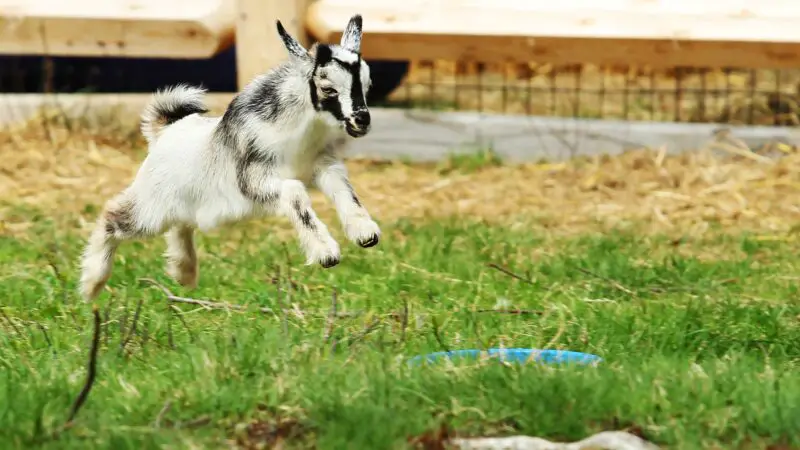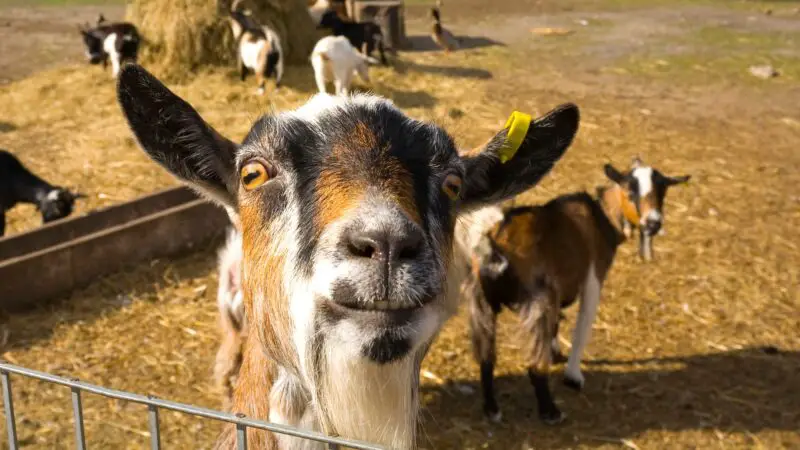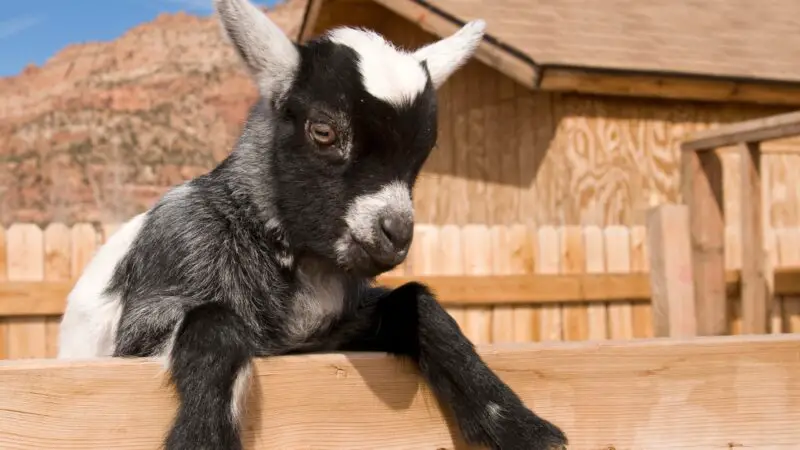Spotting jumping goats is ordinary in farms and the wild. Their natural habitats are mountainous and rocky elevations, and jumping allows them to navigate through difficult terrains.
The adult goats and their kids (baby goats) can jump high. But unlike their parents, baby goats can hardly jump up to twice their height into the air.
Goats jump mostly to escape from predators. They will also likely escape from the barn or loafing shed with low fences to explore the surroundings. Jumping is part of daily exercise to stretch their muscles and practice balance and coordination. Goats also jump to reach their food, play, and when they are frightened.
Also called stotting, most goats jump regardless of breed and age. Surprisingly, these mammals can jump to extraordinary heights. Aside from jumping, these talented animals also climb trees using their specially adapted hooves and extremely powerful legs. In this article, you will learn everything about goats jumping and how to deal with them.
Why Do Baby Goats Jump?

Baby goats jump as part of their energetic and playful behavior. They jump more often than adults.
These kids also jump to bond with their mothers, socialize with each other, investigate new objects and areas, and escape from predators. They may not be able to jump as high as adults, but baby goats jumping is fun to watch.
Is Jumping a Natural Instinct for Goats?
Jumping is an instinct for goats, whether they are in the wild or domesticated. Goats are active, curious, and alert, and jumping is one of their survival techniques.
They are not territorial and love to explore things around them. These inquisitive mammals have very strong legs and hooves, allowing them to jump high.
Can Jumping Land Goats In Trouble?

Jumping can land goats in trouble. Although they have great talents for jumping, these curious animals can injure themselves after jumping too high and landing awkwardly. Aside from bruises, they can also suffer from sprains and broken bones. Not to mention, jumpy goats can also damage properties in the neighborhood.
Goats can land in dangerous areas like cliffs or get stuck in fences and other obstacles. In 2016, a viral video showed a goat hanging on power lines with its horns. It happened in Greece, and the goat was eventually rescued using a ladder. It’s unclear how the goat reached that high, but one can assume it jumped or climbed the trees.
How High Can Goats Jump?
The actual height that a goat can jump mainly depends on the breed, age, and size. But on average, adult goats can jump at 4 to 5 ft (1.2 to 1.5 m) or higher. Kids may jump a little lower, though. Yet, according to National Geographic, mountain goats (Oreamnos americanus) can jump nearly up to 12 ft (3.6 m) high with just a single leap.
Not all goat breeds can jump high, though. Note that weight is a huge factor for goats when jumping. For instance, Boer goats are the world’s largest goat breed. Mature Boer bucks weigh 240-300 lbs (108.9-136.0 kilos), and a mature doe weighs 200-225 lbs (90.7-102.0 kilos). These heavy goats can only jump up to 3.5 ft above the ground.
What Do Goats Like to Jump On?

Goats like to jump on almost everything they find interesting. They may jump on tree branches, huge rocks, logs, and fences.
Playful kids may frequently jump into their mother’s back and even on your lap. Interestingly, these baby goats also jump even if there is nothing to jump on and will land in the same spot where they are standing.
How to Hobble a Goat to Keep From Jumping
To hobble a goat means putting something on its legs so the animal can no longer jump. But while it seems inhumane to tie a goat’s leg, using a hobble is mostly done while milking a difficult goat. Hobbles can also be used in goats while shaving their udders (mammary glands). Here are some tips on how to hobble a goat properly:
- DIY (Do-It-Yourself) goat hobbles can be a rope or a dog leash. Create two loops out of the rope, with one of them a little bit tight and the other quite loose.
- A better alternative to rope is a commercial goat hobble strap, such as from Pranovo. These products are very sturdy and easy to adjust.
- A BINDING TOOL: Goat hobbles are a binding tool for the goat's...
- SAFE AND EFFECTIVE: Goat Hobbles are a safe and effective way to...
- WIDE,THICK AND STURDY: The straps are wide, thick and sturdy...
- CONSIDERATE DESIGN: These hobbles are made with loop closures for...
- MILK A DIFFICULT GOAT: Hobbles are simple really, just a wide...
- Place the hobble around the hind legs of the goat. Make sure it is above the hocks or elbows of its back legs.
- Ensure the goat can still somehow move even if its leg has a hobble.
- Never put the hobble lower or around the ankles. Otherwise, the goat can easily kick them off.
- Once the milking is finished, remove the hobble carefully.
How to Keep Goats From Jumping off the Fence?
If properly taken care of, domesticated goats seldom jump over the fence from the ground, except when there are predators or anything that pressures them to escape. However, these intelligent animals will test the fence by jumping or opening the gate. Therefore, here are some useful tips on how to prevent goats from jumping the fence:
1. Build taller fences with deeper posts.
Regardless of the type of fences you have, make sure they are taller than the average jump height of your goats, preferably 5 feet above. The support posts should also be at least 2 feet deep, so the goats cannot push them. Also, avoid installing fences near elevated areas, as they can help the goats jump higher. Instead, choose a flat surface.
2. Make sure goats are safe.
Avoid using barbed wires to ensure that goats are not harmed while they try to push or jump. If you use woven or galvanised wire fences, the mesh should be around 2 x 4 inches. This will minimize the chances of the goat horns getting tangled. If you prefer using an electric fence, the recommended voltage is 4500 to 9000 volts.
- Galvanized and rustpfoof: Galvanized before welding. Made of...
- Suitable size: strong 15gauge hardware cloth provides optimal...
- Easy to install: flexible design of this hardware cloth makes...
- Applications for various scence: with 2"X4" holes wire mesh,...
- Customer Care: We are dedicated to provide premium products for...
3. Make the outer side less attractive
Goats are likely to escape if they notice that the outer side of the fence is more attractive than the inside. Therefore, make sure that there is no grass outside that will attract the goats. Instead, make the grass greener inside the pasture. If you have only two or three goats, adding more to your herd can also help discourage them from escaping.
Related Questions
How High Can a Nigerian Dwarf Goat Jump?
The Nigerian dwarf goat (Capra aegagrus hircus) can have an adult weight of 40 to 60 lbs (18.1 to 27.2 kilos). Adult females can grow 16-20 inches (40.6-50.8 cm), while adult males can be as tall as 23 inches (58.4 cm). Although small and lightweight, these amazing miniature goats can jump up to 4 feet high or more than double their height.
How High Can Pygmy Goats Jump?
The Pygmy goat is a dwarf goat that weighs around 40-70 lbs (18.1 to 31.7 kilos). Like the Nigerian dwarf goat, males can reach up to 23 inches tall.
But because their feet are shorter and quite heavier, the average height that Pygmy goats can jump is about 3.5 feet (42 inches). But in some cases, they can also jump at 4 feet.
Can a Goat Jump a Four-Foot Fence?
Most goats can jump a 4-foot fence even if they belong to a smaller breed. As mentioned earlier, these animals are incredibly high jumpers.
The smaller the goat, the easier it can get off the ground. Some small goats can jump higher than 4 feet. This is why you should not focus only on fences if you don’t want them to escape.


